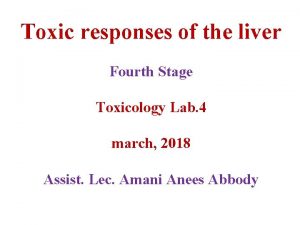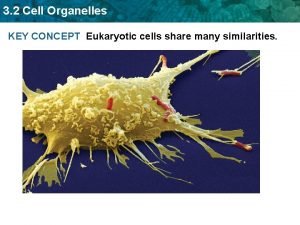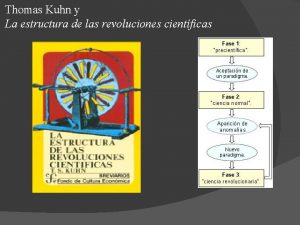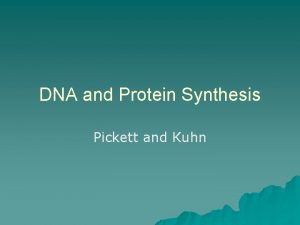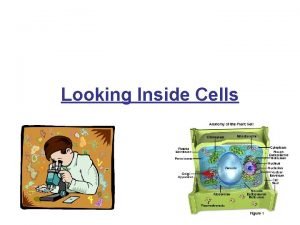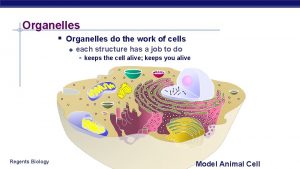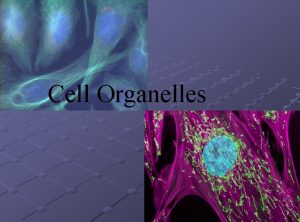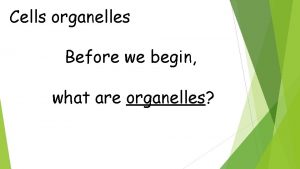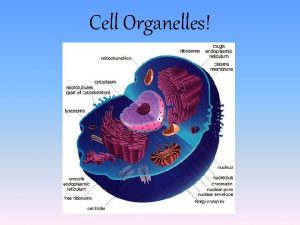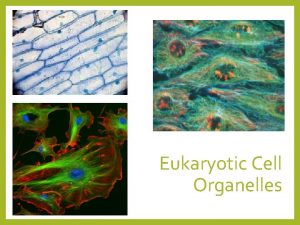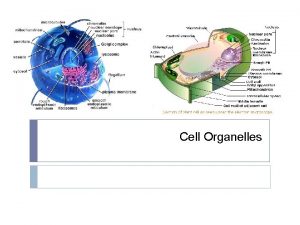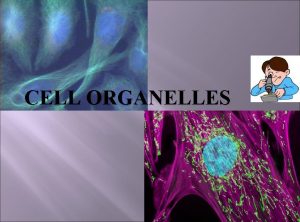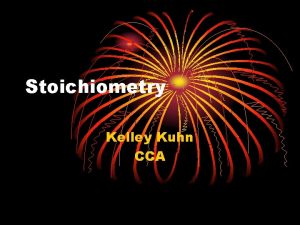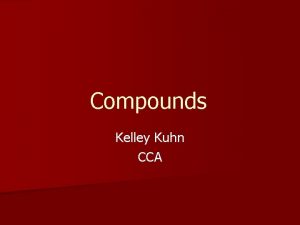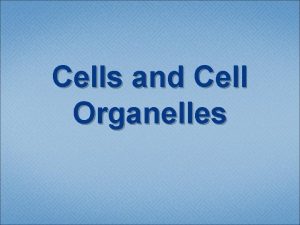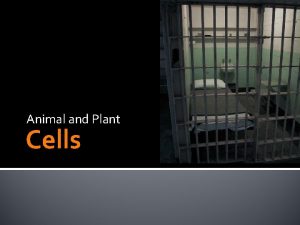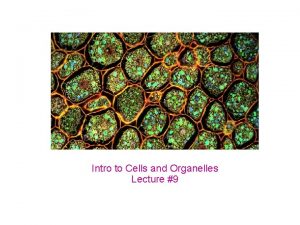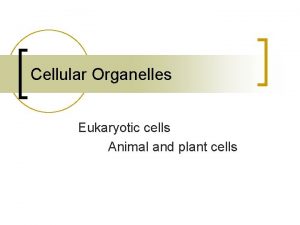Cells and Organelles Jack Pickett and Kelley Kuhn


































- Slides: 34

Cells and Organelles Jack Pickett and Kelley Kuhn Center for Creative Arts

Characteristics of living things All living thing: �are made of one or more cells. �Display organization. �Grow and develop. �Reproduce. �Respond to stimuli. �Require energy. �Maintain homeostasis.

Prokaryotes and Eukaryotes 4. 5 billion years ago 3. 5 billion years ago 1. 5 billion years ago 0. 5 billion years ago Earth formed First life—prokaryotic bacteria dominate Nucleated cells arise— eukaryotic Cambrian explosion; multicellular eukaryotes arise

Prokaryotes and Eukaryotes: commonalities �Both have DNA has their genetic material. �Both are membrane bound. �Both have ribosomes. �Both have a similar basic metabolism. �Both are amazingly diverse in forms.

Prokaryotes and Eukaryotes: differences �Eukaryotes have a nucleus and membrane-bound organelles. Prokaryotes do not. �The DNA of a eukaryote is much more complex and is contained in its nucleus. The DNA of prokaryotes is free-floating in the cytoplasm. �The organelles of eukaryotes allow for greater division of labor within the cell than is possible in prokaryotes. �Eukaryotic cells are 10 x larger than prokaryotic cells on average. �The cell wall of prokaryotes contain peptidoglycan while eukaryotic cells with cell walls do not.

Kingdoms of living organisms Kingdom Monera Bacteria: Archaebacteria, eubacteria Unicellular organization Prokaryotes; nucleus lack membrane Protista Protozoa, brown, red and some green algae, yeast, kelp, phycomycetes, myxomycetes Unicellular Eukaryotes; organization with membrane-bound some exceptions nucleus and organelles Fungi Ascomycetes, basidiomycetes, etc. Multicellular Motionless and nonphotosynthetic Plantae Angiosperms, conifers, bryophytes, mosses, some green algae Multicellular Motionless, photosynthetic Animalia Vertebrate and invertebrate Multicellular Motile, nonphotosynthetic

So, whadya remember from 7 th grade? for each of the following organelles and cell parts, match one of more of the accompanying attributes. Make sure you select attribute that matches, not just one. Mitochondria a. Has a double membrane Endoplasmic reticulum b. Generates energy Golgi apparatus (complex) c. Produces proteins Lysosome d. Storage Ribosome e. Modifies proteins Vacuole f. Produces sugars Chloroplast g. Produces lipids Cell membrane h. Holds digestive enzymes Nucleus i. Contains DNA j. Controls cell activities k. Regulates what enters cells.

So, whadya remember from 7 th grade? Correct answers: Mitochondria (a, b) a. Has a double membrane Endoplasmic reticulum (c, g) b. Generates energy Golgi apparatus (complex) (e) c. Produces proteins Lysosome (h) d. Storage Ribosome (c) e. Modifies proteins Vacuole (d) f. Produces sugars Chloroplast (a, f) g. Produces lipids Cell membrane (k) h. Holds digestive enzymes Nucleus (i, j) i. Contains DNA j. Controls cell activities k. Regulates what enters cells.

Chapter 7 �Homework: due Friday, October 14 � 7. 1: 3, 4 � 7. 2: 1 -5 � 7. 3: 1, 2, 4 � 7. 4: 1 -4

Bell work: �As a table, make a flow chart comparing the parts of a cell to an automobile production line. �Some organisms that normally live in pond water contain water pumps. These pumps continually pump water out of the cell. Why must these cells do this? �Describe a scenario where the above cells might have to reverse the action of the pump.


Cells under the microscope! �Microscope tips: use only the fine adjustment (small knob) to focus the microscope. The large knob is the coarse adjustment; using it on medium or high power may result in breaking the slide. �Sketching tips: �Do not try to sketch everything in your field of view; just be sure that whatever you draw is TO SCALE within the provided circle �Draw lightly and then darken as needed. Use your eraser to help with shading. �USE A PENCIL! We have some pencils to lend if you need them. Lab drawings should never be done in pen. �Pick one cell to draw and complete first then add cells as you have time.

Mitochondria (in blue, highlighted manually)

Mitochondria

Mitchondria, crysta type

Mitochondria, tubular type

Mitochondria

Lysosomes and rough. ER

Lysosome of eosinophil

Golgi apparatus

Golgi apparatus

Centrioles

Centrioles

Endoplasmic reticulum

Endoplasmic reticulum/golgi apparatus collaboration 1 Nucleus 2 Nuclear pore 3 Rough endoplasmic reticulum (RER) 4 Smooth endoplasmic reticulum (SER) 5 Ribosome on the rough ER 6 Proteins that are transported 7 Transport vesicle 8 Golgi apparatus 9 Cis face of the Golgi apparatus 10 Trans face of the Golgi apparatus 11 Cisternae of the Golgi apparatus

ER human liver

Endoplasmic reticulum, mitochondria and nucleus

Chloroplasts in cell; chloroplast enlarged

Tobacco chloroplasts, cell view and enlarged

Chloroplasts in plant cells

Chloroplast, real and model

Nucleus with nucleolus

Nucleus and parts

�Interactive plant and animal cells �http: //www. cellsalive. com/cells/cell_model. htm �Click on the organelle for description: �http: //learn. genetics. utah. edu/content/begin/cells/in sideacell/ �Animated cell—can you guess what represents what process? �http: //www. studiodaily. com/main/searchlist/6850. ht ml
 Thomas kuhn elizabeth kuhn
Thomas kuhn elizabeth kuhn Cell substance
Cell substance Lake pickett boat ramp
Lake pickett boat ramp Battle of gettysburg day 3 map
Battle of gettysburg day 3 map Plant vs animal cell
Plant vs animal cell Liver cells organelles
Liver cells organelles Organelles in eukaryotic cells worksheet
Organelles in eukaryotic cells worksheet Main characters in jack and the beanstalk
Main characters in jack and the beanstalk Paranasal sinuses development
Paranasal sinuses development Chlorocruorin
Chlorocruorin Plant and animal cells venn diagram
Plant and animal cells venn diagram Masses of cells form and steal nutrients from healthy cells
Masses of cells form and steal nutrients from healthy cells Papillary duct of bellini
Papillary duct of bellini Thyroid gland
Thyroid gland Haploid and diploid venn diagram
Haploid and diploid venn diagram Why dna is more stable than rna
Why dna is more stable than rna Prokaryote vs eukaryote worksheet
Prokaryote vs eukaryote worksheet Prokaryotic vs eukaryotic cells venn diagram
Prokaryotic vs eukaryotic cells venn diagram Cell organelle jeopardy
Cell organelle jeopardy Pseudostratified vs simple columnar
Pseudostratified vs simple columnar What cell type
What cell type Prokaryotic cells
Prokaryotic cells Chapter 8 cellular reproduction cells from cells
Chapter 8 cellular reproduction cells from cells Säulen der traumapädagogik
Säulen der traumapädagogik Ciencia segun thomas kuhn
Ciencia segun thomas kuhn Positivism sociology
Positivism sociology Thomas samuel kuhn
Thomas samuel kuhn Thomas samuel kuhn
Thomas samuel kuhn Popper vs kuhn
Popper vs kuhn Popper vs kuhn
Popper vs kuhn Amrican poker
Amrican poker Chandlee kuhn
Chandlee kuhn Peter kuhn model
Peter kuhn model Victor spinski
Victor spinski Thomas kuhn a tudományos forradalmak szerkezete pdf
Thomas kuhn a tudományos forradalmak szerkezete pdf





